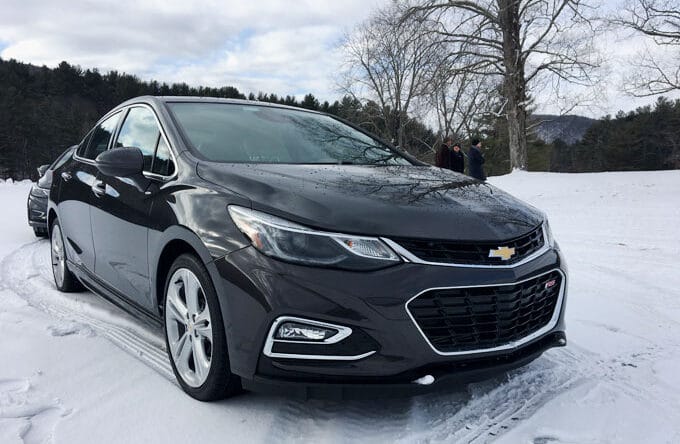Take on Snow and Ice with These Tips for Driving in Winter Weather

The most important safety system in your car is you – the driver.
Growing up in upstate New York between Buffalo and Lake Placid, it seemed I was always driving in snow. I knew to take it seriously and somehow just figured out how to do it without much concern. But people who live outside the reach of those lake-effect snowstorms don’t always take snow-covered roads as seriously, and they often lack the experience of logging miles in snow.
Chevrolet wants you to be safe in the snow, so the company invited me to Lime Rock Park in Connecticut to learn some winter driving tips. I got to practice driving on a snow-covered, closed course with a professional driving instructor so I could pass on what I learned.
I hopped in a beautiful Chevy Cruze with my instructor, Don. And while I thought I was a pretty good driver in the snow, I definitely learned a few things!
1. Don’t crank the steering wheel.
Learning more about how a car reacts to steering was enlightening. It’s instinct to turn the wheel to the right if you want your car to turn right. But cranking the wheel too much – or continuing to steer when you’re headed into a skid – will only serve to throw you farther off your intended course. Instead, ease up on the steering wheel and apply the brakes.
Believe me, this is not an easy technique to master! Electronically, the car knows you want to go to the right and senses you are losing control, so it wants to help. After a couple skids off-course, I learned to ease off the steering wheel and instantly felt the Chevy Cruze’s rear brakes engage and pivot the back of the car to put me in the right direction. It was definitely an eye-opener.
2. Look ahead to where you want to go.
Don also taught me to look where I want to be, not where I am. Have you ever been driving along and looked over at the radio or the person in the seat next to you? What happens? You drift in the direction you’re looking because your hands automatically and unwittingly move you where you are looking.
When I slid off course, I was looking off course.
Don taught me to always be looking ahead to the next turn – even looking out the side window. So if you’re driving in wintry conditions and feel yourself losing control as you round a curve:
- ease off the steering wheel
- look ahead to where you want to go
- apply the brake.
If you’re headed for a tree – DO NOT look straight at the tree. Again, not an easy thing to do!
3. Don’t pump the brakes.
Now let’s talk about braking. When I was learning to drive, cars did not have anti-lock brakes. We were always taught to “pump” the brakes lightly and quickly – to avoid “locking up” – if we wanted to stop on a slick surface. Cars today are equipped with ABS (anti-lock brake systems), so pumping the brake does nothing for you. Apply the brake firmly, steer gently, look ahead and let the car do its job.

Steering and braking are important tools in winter driving safety. Photo by Shannon Entin for A Girls Guide to Cars.
The Things You Already Know.
Driving in wintry conditions is dangerous and you’ve no doubt heard the usual advice:
- Remove all snow and ice from your vehicle so you can see properly
- Make sure your tires and battery are in good condition
- Carry an emergency kit in your trunk (even some kitty litter to help you gain traction should you get stuck)
Plus 5 More Little-Known Winter Driving Tips.
Chevrolet has some additional, little-known tips to help you drive better in winter weather:
- The most dangerous/slippery temperature range is between 24 – 34 degrees. You likely have a mental note that anything below 32 degrees Fahrenheit is dangerous, but in reality, the worst range is 24 – 34 degrees when there is snow or ice on the ground. Cars driving on a snow/ice covered surface in that range cause the snow/ice to melt and wet snow/ice has less grip than solid snow/ice.
- Snow has half the traction of a dry surface and ice has 75 percent less traction. Adjust your speed and braking accordingly.
- Take off bulky coats and gloves. Driving is a sensory experience and bulky gloves can mute the feedback through the steering wheel. It also makes it more difficult for you to operate the secondary controls such as turn indicators and the heat. Bulky coats can restrict your arm movement and limit your reactions in the event of an emergency.
- Turn down the heat. Speaking of heat, you should avoid the urge to turn the interior of your vehicle into a sauna as you attempt to chase the chill away. Keeping the inside of your car too warm can make you drowsy. You should remain alert at all times when driving, especially in winter conditions.
- Don’t wear big snow boots. Just like bulky coats and gloves, big boots can also slow your reaction time in an emergency situation. And thick boots make it more difficult to feel the accelerator and brake pedals.

5 Little-known winter driving tips from Chevy. Photo by Shannon Entin for A Girls Guide to Cars.
The easiest way to stay safe in a winter storm is to stay off the roads. But if you must drive, remember the driver is the best safety system in the car!
I was a guest of Chevrolet for this #ChevySnowDay Winter Driving event. All opinions are my own. Special thanks to Don for capturing video of my driving experience!
